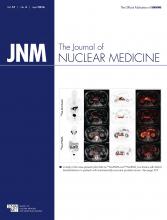Cancer imaging using 18F-fluromisonidazole (18F-FMISO) has been developed over the past 30 y and is the most established agent for noninvasively assessing hypoxia. Research into hypoxia imaging agents began, as many imaging agents arise, through laboratory investigations using cultured cancer cells in controlled oxygen environments (1). Development of 18F-FMISO was validated through studies of cell spheroids, animal imaging and tissue validation (2–4), and eventually human imaging in cancer patients (5). The process of development of a PET imaging agent for hypoxia in human imaging necessarily proceeded from a complex dynamic imaging protocol with concomitant arterial sampling to a simple clinically feasible static imaging session without blood sampling, maintaining quantitative accuracy required to make the imaging study clinically useful.
Current static imaging methods for 18F-FMISO quantification of hypoxia distribution have been shown to be useful in the prediction of outcome and time to progression in a wide range of cancers (6–9). We have proposed using 18F-FMISO hypoxic volume distribution, where hypoxic volume comprises the pixels greater than a tissue-to-blood ratio of 1.2, for planning hypoxia-targeted regions for escalated radiotherapy dose (10). This approach has been tested in patients with head and neck cancer and was found to be not only feasible, but also superior to uniform dose prescription (11–13).
In the March 2016 issue of The Journal of Nuclear Medicine, a proposal is provided using a dynamic imaging sequence with kinetic analysis of 18F-FMISO, potentially to generate an equivalent image of hypoxia for dose planning (14). A similar distribution from dynamic 18F-FMISO imaging would require a much longer dynamic imaging session and possibly blood sampling for input function determination, in addition to specialized software for the creation of parametric images from the dynamic sequence. Dynamic imaging protocols are not considered clinically feasible for routine imaging performed at most medical centers unless they have been demonstrated to provide substantial added benefit over simple static images, in a positive cost–benefit ratio.
Dynamic imaging is time consuming, and blood sampling, counting, and cross-calibration with the scanner are complex and not readily extensible to a nonresearch clinical imaging center. Additionally, some clinical scanners cannot perform dynamic acquisition and many centers do not have the technical expertise to process dynamic image data. Moreover, we are not aware of any study that has shown with convincing evidence that dynamic imaging of 18F-FMISO has added value in the discrimination of tumor hypoxia or has shown an advantage in predicting outcome variables commonly used to manage patients in the clinic, such as time-to-progression or overall survival.
Some reports hypothesized that the combination of severe chronic tissue hypoxia along with abnormal vasculature may lead to low total uptake of 18F-FMISO late after injection, but this has never been shown in human 18F-FMISO imaging. If chronic hypoxia occurs in tumors, even with restricted delivery over 2 h of tracer uptake, 18F-FMISO will be reduced and fixed in the tissue by bioreduction from ubiquitous nitroreductase enzymes in cells that are alive. With acute hypoxia, transient oxygen peaks can release 18F-FMISO from tissue, lowering the bound tracer signal. 18F-FMISO was never designed to assess acute transient hypoxia, and dynamic imaging may play a role in assessing that situation if and when it is clinically relevant.
For many cancers, including those of the head and neck, the 18F-FMISO static imaging protocol has become as facile as 18F-FDG imaging, allowing quantitation by normalizing uptake to a blood pool in the field of view. From the patient’s perspective, it is as easy as a bone scan and it does not require fasting, as is required with 18F-FDG PET. The essential parameters are easily obtained for assessing hypoxia, stratifying patients for hypoxia-selective drugs, or delineating severely hypoxic regions for a radiation boost.
Adding complexity and imaging time without added value to the clinical assessment of hypoxia is unnecessary. However, there may be some areas of imaging research that benefit from dynamic acquisition of 18F-FMISO to validate the biochemistry of nitroreductase enzymes or genetic signatures associated with chronic hypoxia. For example, there is some suggestion that transient hypoxia occurs as a late response in patients treated with bevacizumab, and this could be a clinical situation in which dynamic 18F-FMISO imaging would have an advantage in assessing transient hypoxia.
To summarize, 18F-FMISO PET started with 2-h dynamic protocols with kinetic analysis, but clinical studies have affirmed that static images at a time after injection when this freely diffusible radiopharmaceutical has distributed uniformly to normoxic tissue is useful. At this time after tracer injection only hypoxic tissues show increased uptake well above the equilibrium ratio of 1. The nuclear medicine community is best served by keeping protocols as simple as possible, and it is the requirement of investigators proposing more complicated studies to show prospectively that there is added value in the new procedure using a Cox model of proportional hazards or something similar.
DISCLOSURE
No potential conflict of interest relevant to this article was reported.
Footnotes
Published online Feb. 18, 2016.
- © 2016 by the Society of Nuclear Medicine and Molecular Imaging, Inc.
REFERENCES
- Received for publication January 15, 2016.
- Accepted for publication January 19, 2016.







